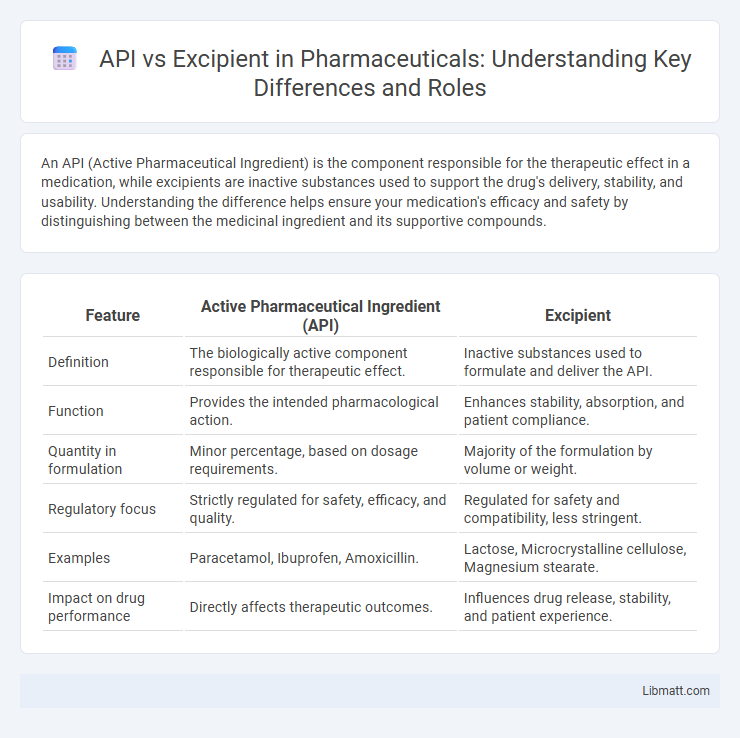An API (Active Pharmaceutical Ingredient) is the component responsible for the therapeutic effect in a medication, while excipients are inactive substances used to support the drug's delivery, stability, and usability. Understanding the difference helps ensure your medication's efficacy and safety by distinguishing between the medicinal ingredient and its supportive compounds.
Table of Comparison
| Feature | Active Pharmaceutical Ingredient (API) | Excipient |
|---|---|---|
| Definition | The biologically active component responsible for therapeutic effect. | Inactive substances used to formulate and deliver the API. |
| Function | Provides the intended pharmacological action. | Enhances stability, absorption, and patient compliance. |
| Quantity in formulation | Minor percentage, based on dosage requirements. | Majority of the formulation by volume or weight. |
| Regulatory focus | Strictly regulated for safety, efficacy, and quality. | Regulated for safety and compatibility, less stringent. |
| Examples | Paracetamol, Ibuprofen, Amoxicillin. | Lactose, Microcrystalline cellulose, Magnesium stearate. |
| Impact on drug performance | Directly affects therapeutic outcomes. | Influences drug release, stability, and patient experience. |
Introduction to APIs and Excipients
Active Pharmaceutical Ingredients (APIs) are the biologically active components in medications responsible for therapeutic effects, while excipients are inert substances used to formulate and stabilize the drug product. APIs determine the drug's efficacy and mechanism of action, whereas excipients facilitate drug delivery, enhance stability, and improve patient acceptability. Understanding the distinct roles of APIs and excipients is critical for pharmaceutical formulation, regulatory approval, and ensuring overall medication safety and efficacy.
Definition of Active Pharmaceutical Ingredients (APIs)
Active Pharmaceutical Ingredients (APIs) are the biologically active components in drugs responsible for the intended therapeutic effects. APIs undergo rigorous quality control and validation to ensure potency, purity, and safety in pharmaceutical formulations. Understanding the distinction between your drug's API and excipients is crucial for effective treatment outcomes and formulation stability.
Definition of Excipients in Pharmaceuticals
Excipients in pharmaceuticals are inactive substances used alongside the active pharmaceutical ingredient (API) to formulate a medication. These components serve vital roles such as enhancing drug stability, controlling release rates, and improving taste or appearance. Understanding the function of excipients is essential for optimizing your medication's efficacy and safety.
Key Differences Between APIs and Excipients
Active Pharmaceutical Ingredients (APIs) are the bioactive components responsible for the therapeutic effects of a medication, while excipients serve as inactive substances that facilitate drug delivery, stability, and patient compliance. APIs determine the drug's efficacy and pharmacological action, whereas excipients influence the drug's formulation, absorption, and shelf life without contributing to its medicinal properties. Understanding these key differences is crucial for optimizing your pharmaceutical formulation to ensure safety, effectiveness, and manufacturability.
Roles and Functions: API vs Excipient
The Active Pharmaceutical Ingredient (API) is responsible for delivering the therapeutic effect by targeting specific biological pathways, while excipients serve as inert substances that facilitate drug formulation, stability, and delivery. Excipients enhance the absorption, taste, and shelf-life without contributing to the drug's direct pharmacological action. Your medication's effectiveness largely depends on the precise balance and interaction between the API and excipients within the formulation.
Importance of APIs in Drug Formulation
Active Pharmaceutical Ingredients (APIs) are the biologically active components responsible for the therapeutic effects of medications, making them essential in drug formulation. Excipients serve primarily as inactive substances that aid in drug delivery, stability, and patient acceptability but do not contribute to the pharmacological activity. The precise selection and optimization of APIs determine the efficacy, safety, and dosage strength of pharmaceutical products.
Importance of Excipients in Drug Delivery
Excipients play a crucial role in drug delivery by enhancing the stability, solubility, and bioavailability of the Active Pharmaceutical Ingredient (API), ensuring optimal therapeutic efficacy. They facilitate controlled release, improve drug absorption, and provide protection from degradation during manufacturing and storage processes. Effective formulation relies on selecting the right excipients to complement the API and meet specific dosage form requirements.
Regulatory Aspects: APIs vs Excipients
Regulatory frameworks distinguish APIs (Active Pharmaceutical Ingredients) from excipients based on their roles and safety profiles, with APIs subjected to stringent evaluation for efficacy, pharmacokinetics, and toxicology under agencies like the FDA and EMA. Excipients undergo regulated assessments primarily focusing on safety, quality, and compatibility, often referenced in pharmacopeial standards such as USP and Ph.Eur. Both require rigorous documentation, but the regulatory burden is heavier for APIs due to their direct therapeutic effect and impact on drug formulation performance.
Quality Control and Safety Considerations
Quality control of API (Active Pharmaceutical Ingredient) involves stringent testing of identity, purity, and potency to ensure therapeutic efficacy, while excipients undergo rigorous evaluation for compatibility, stability, and lack of toxicity to ensure formulation safety. Safety considerations prioritize minimizing impurities and contaminants in APIs to prevent adverse reactions, whereas excipients must be non-reactive and biocompatible to avoid compromising drug delivery or causing side effects. Analytical methods such as HPLC, mass spectrometry, and microbial limits testing are essential for both APIs and excipients to maintain compliance with regulatory standards and ensure patient safety.
Summary: Choosing the Right API and Excipient
Selecting the right Active Pharmaceutical Ingredient (API) and excipient is crucial for drug formulation, as APIs provide the therapeutic effect while excipients ensure stability, bioavailability, and patient acceptability. The compatibility between APIs and excipients affects drug solubility, absorption, and shelf life, requiring thorough compatibility testing and regulatory compliance. Optimizing the balance between API potency and excipient functionality enhances drug efficacy, safety, and manufacturability in pharmaceutical development.
API vs excipient Infographic

 libmatt.com
libmatt.com